Docks And Shipbuilding
Having in the previous chapters treated of the subjects of ancient navigation and ships, and given some account of the boats of the present time, we now proceed to write about modern ships. In doing so, let
us turn our attention first to:—
The Dockyard.
If we were a maker of riddles, we would ask our reader, “Why is a ship like a human being?” and having added, “D’ye give it up?” would reply, “Because it commences life in a cradle;” but not being a fabricator of riddles, we don’t ask our reader that question. We merely draw his attention to the fact that ships, like men, have not only an infancy, but also have cradles—of which more hereafter.
Let us enter one of those naval nurseries—the dockyard—where ships may be seen commencing their career. What a scene it is! What sawing and thumping, and filing, and grinding, and clinching, and hammering, without intermission, from morn till noon, and from noon till dewy eve! What a Babel of sounds and chaos of indescribable material!
That little boy whom you observe standing under the shadow of yonder hull—his hands in his pockets (of course), his mouth open (probably), and his eyes gazing up fixedly at the workmen, who cluster like bees on the ribs and timbers of yonder infant ship has stood there for more than an hour, and he will stand there, or thereabout, for many hours to come; for it happens to be a holiday with him, and he dotes on harbours and dockyards. His whole being is wrapped up in them.
And this is natural enough. Most boys delight to gaze on incomprehensible and stupendous works. Let us—you and I, reader—follow this urchin’s example, keeping our mouths shut, however, save when we mean to speak, and our eyes open.
There are ships here of every shape and size—from the little coasting-vessel to the great East Indiaman, which, in its unfinished condition, looks like the skeleton of some dire megatherium of the antediluvian world. Some of these infant ships have an enormous shed over them to protect them from the weather; others are destitute of such protection: for ships, like men, it would seem, are liable to vicissitudes of fortune. While the “great ones” of the dockyard world are comfortably housed, the small ones are not unfrequently exposed to the fitful buffeting of the rude elements even from their birth.
There are ships here, too, in every state of progression. There, just beside you, is a “little one” that was born yesterday. The keel has just been laid on the blocks; and it will take many a long day of clinching and sawing and hammering ere that infant assumes the bristling appearance of an antediluvian skeleton. Yonder is the hull of a ship almost completed. It is a gigantic infant, and has the aspect of a very thriving child. It evidently has a robust constitution and a sturdy frame. Perhaps we may re-visit the dockyard to-morrow, and see this vessel launched.
Besides these two, there are ships with their ribs partially up, and ships with their planking partially on; and in a more distant part of the yard there are one or two old ships hauled up, high and dry, to have their bottoms repaired and their seams re-pitched, after many a rough and bravely-fought battle with the ocean waves.
Now that we have gazed our fill at the general aspect of the dockyard, let us descend a little more to particulars. We shall first tell of the:—
Nature and Use of Docks.
There are two kinds of docks—dry and wet. A dry-dock is usually constructed with gates, to admit or shut out the tide. When a ship arrives from a long voyage, and needs repair to the lower part of her hull, she must be got out of the water somehow or other.
This object is frequently attained in regard to small vessels by simply running them gently on the flat sand or mud beach of a bay or harbour, so that, when the tide retires, they shall be left dry. 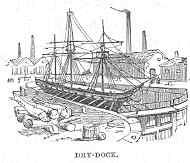 But it would be dangerous as well as inconvenient to do this with large ships, therefore dry-docks have been constructed for this purpose. They are so built that when the tide is full the dry-docks are also full. When thus full of water, the gates of a dry-dock are opened, and the large ship is dragged slowly in, after which the gates are shut. The tide then retires, leaving it in this basin of water. The ship is then propped up on all sides with timbers, in such a way that she stands upright, “upon an even keel,” and thus, the pressure on her hull being equally distributed, she is not damaged.
But it would be dangerous as well as inconvenient to do this with large ships, therefore dry-docks have been constructed for this purpose. They are so built that when the tide is full the dry-docks are also full. When thus full of water, the gates of a dry-dock are opened, and the large ship is dragged slowly in, after which the gates are shut. The tide then retires, leaving it in this basin of water. The ship is then propped up on all sides with timbers, in such a way that she stands upright, “upon an even keel,” and thus, the pressure on her hull being equally distributed, she is not damaged. 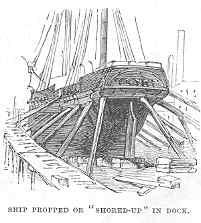 Then the water is let out by means of sluices in the gates, or it is pumped out, and the ship left dry. When the tide returns, the gates and sluices are all shut, and its entrance into the dock prevented, until such time as the ship is repaired, when water is let slowly in. As the vessel floats, the props and supports fall away, the gates of her hospital are opened, and off she goes again, in all the vigour of recruited health, to wing her way over the billows of the great deep.
Then the water is let out by means of sluices in the gates, or it is pumped out, and the ship left dry. When the tide returns, the gates and sluices are all shut, and its entrance into the dock prevented, until such time as the ship is repaired, when water is let slowly in. As the vessel floats, the props and supports fall away, the gates of her hospital are opened, and off she goes again, in all the vigour of recruited health, to wing her way over the billows of the great deep.
A wet-dock is somewhat similar to a dry-dock, the chief difference being that ships while in it are kept floating in water.
Docks are not only used, however, for repairing and building ships. They are also used for loading and unloading them; and as ships are entering and departing from them almost constantly, the busy, bustling, active scene they present is always agreeable.
The principal docks in the United Kingdom are as follows:—
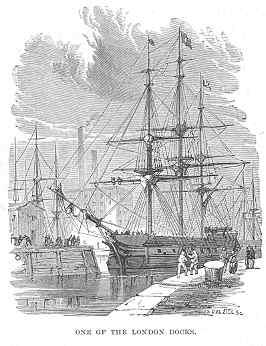
Docks on the Thames—namely, East and West India Docks, London Docks, Saint Katherine’s Docks, Commercial Docks, Victoria Docks.
Southampton Docks.
Liverpool and Bristol Docks.
Hull Docks.
Glasgow Docks.
Dundee Docks.
Leith Docks.
Birkenhead Docks.
So much for docks in passing. Let us now turn our attention to the process of:—
Building a Ship.
As we think it highly improbable that any of our readers intend to become either ship-carpenters or ship-architects, we will not worry them with technical explanations. To give an easily understood and general idea of the manner of building a ship is all we shall attempt. The names of those parts only that are frequently or occasionally referred to in general literature shall be given.
The term ship is employed in two significations. In familiar language it denotes any large or small vessel that navigates the ocean with sails. In nautical language it refers solely to a vessel having three masts, each consisting of a lower-mast, a top-mast, and a top-gallant-mast. At present we use the term ship in the familiar sense.
Elaborate and complicated drawings having been prepared, the shipbuilder begins his work.
The keel is the first part of a ship that is laid. It is the beam which runs along the bottom of a boat or ship from one end to the other. In large ships the keel consists of several pieces joined together. Its uses are, to cause the ship to preserve a direct course in its passage through the water; to check the leeway which every vessel has a tendency to make; and to moderate the rolling motion. The keel is also the ground-work, or foundation, on which the whole superstructure is reared, and is, therefore, immensely strong and solid. The best wood for keels is teak, as it is not liable to split.
Having laid the keel firmly on a bed of wooden blocks, in such a position that the ship when finished may slide into the water stern foremost, the shipbuilder proceeds next to erect the stem and stern posts.
The stem-post rises from the front end of the keel, not quite perpendicularly from it, but sloping a little outwards. It is formed of one or more pieces of wood, according to the size of the ship; but no matter how many pieces may be used, it is always a uniform single beam in appearance. To this the ends of the planks of the ship are afterwards fastened. Its outer edge is called the cut-water, and the part of the ship around it is named the bow.
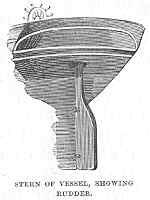
The stern-post rises from the opposite end of the keel, and also slopes a little outwards. To it are fastened the ends of the planking and the framework of the stern part of the ship. To it also is attached that little but most important part of a vessel, the rudder. The rudder, or helm, is a small piece of timber extending along the back of the stern-post, and hung movably upon it by means of what may be called large iron hooks-and-eyes. By means of the rudder the mariner guides the ship in whatever direction he pleases. The contrast between the insignificant size of the rudder and its immense importance is very striking. Its power over the ship is thus referred to in Scripture,—“Behold also the ships, which, though they be so great, and are driven of fierce winds, yet are they turned about with a very small helm, whithersoever the governor listeth.” The rudder is moved from side to side by a huge handle or lever on deck, called the tiller; but as in large ships the rudder is difficult to move by so simple a contrivance, several ropes or chains and pulleys are attached to it, and connected with the drum of a wheel, at which the steersman stands. In the largest ships two, and in rough weather four men are often stationed at the wheel.
The ribs of the ship next rise to view. These are curved wooden beams, which rise on each side of the keel, and are bolted firmly to it. They serve the same purpose to a ship that bones do to the human frame—they support and give strength to it as well as form.
The planks follow the ribs. These are broad, and vary in thickness from two to four inches. They form the outer skin of the ship, and are fastened to the ribs, keel, stem-post, and stern-post by means of innumerable pins of wood or iron, called tree-nails. The 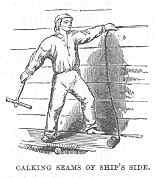 spaces between the planks are caulked—that is, stuffed with oakum; which substance is simply the untwisted tow of old and tarry ropes. A figure-head of some ornamental kind having been placed on the top and front of the stem-post, just above the cutwater, and a flat, ornamental stern, with windows in it to light the cabin, the hull of our ship is complete. But the interior arrangements have yet to be described, although, of course, they have been progressing at the same time with the rest.
spaces between the planks are caulked—that is, stuffed with oakum; which substance is simply the untwisted tow of old and tarry ropes. A figure-head of some ornamental kind having been placed on the top and front of the stem-post, just above the cutwater, and a flat, ornamental stern, with windows in it to light the cabin, the hull of our ship is complete. But the interior arrangements have yet to be described, although, of course, they have been progressing at the same time with the rest.
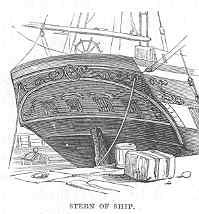
The beams of a ship are massive wooden timbers, which extend across from side to side in a series of tiers. They serve the purpose of binding the sides together, of preventing them from collapsing, and of supporting the decks, as well as of giving compactness and great strength to the whole structure.
The decks are simply plank floors nailed to the beams, and serve very much the same purposes as the floors of a house. They also help to strengthen the ship longitudinally. All ships have at least one complete deck; most have two, with a half-deck at the stern, called the quarter-deck, and another at the bow, called the forecastle. But the decks of large ships are still more numerous. Those of a first-rate man-of-war are as follows—we begin with the lowest, which is considerably under the surface of the sea:—
The Orlop-deck, the Gun-deck, the Middle-deck, the Upper-deck, the Quarter-deck, and the Poop—the latter deck being the highest deck of all, a very small one, at the stern.
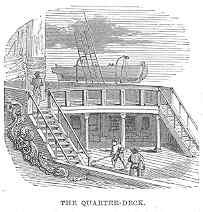
Thus a man-of-war is a floating house with six stories—the poop being the garret, and the orlop-deck the cellars. The upper decks are lighted by sky-lights; those farther down by port-holes (or gun-holes) and windows; the lowest of all by candles or lamps, daylight being for ever banished from those gloomy submarine regions!
The bulwarks rise above the upper-deck, all round the ship, and serve the purposes of protecting the upper-deck from the waves, and supporting the belaying-pins, to which the ropes are fastened. In ships of war the top of the bulwarks forms a sort of trough all round the ship, in which the hammocks (the swinging-beds) of the men are stowed away every morning. This trough is termed the hammock-nettings, and the hammocks are placed there to be well aired. In action the bulwarks serve to protect the crew from musketry.
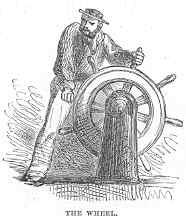
The wheel, which has been already referred to, stands usually at the stern of the ship, on the quarter-deck; but it is sometimes placed on an elevated platform amid-ships, so that the steersman may see more clearly where he is going.
The binnacle stands directly in front of the wheel. It is a species of box, firmly fixed to the deck, in which is placed the compass. It is completely covered in, having a glass window, through which the man at the wheel can observe the course he is steering.
The capstan stands on the main-deck, sometimes near the centre of the vessel, at other times near the bow or the stern. 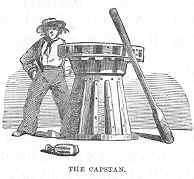 It is a massive block of timber moving on a pivot, which is turned round by wooden levers, called capstan bars, or hand-spikes, and is used for any purpose that requires great tractive power—the drawing in of the cable, for instance, or warping the ship; which means that a rope is fixed on shore, or by an anchor to the bottom of the sea, and the other end of it is coiled round the capstan, so that when the capstan is forced round by the handspikes, the rope coils on to it, and the ship is slowly dragged forward.
It is a massive block of timber moving on a pivot, which is turned round by wooden levers, called capstan bars, or hand-spikes, and is used for any purpose that requires great tractive power—the drawing in of the cable, for instance, or warping the ship; which means that a rope is fixed on shore, or by an anchor to the bottom of the sea, and the other end of it is coiled round the capstan, so that when the capstan is forced round by the handspikes, the rope coils on to it, and the ship is slowly dragged forward.
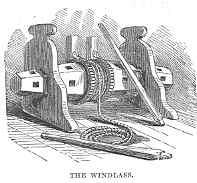
The windlass is simply a horizontal, instead of a perpendicular capstan. Its sole purpose is for heaving up the anchor, and it is placed close to the bow of the ship.
The galley, or cooking-house, is usually near to the windlass, in the front part of the vessel. Here the cook reigns supreme; but this nautical kitchen is wonderfully small. It is just big enough to hold the fireplace and “coppers,” with a small shelf, on which the cook (always a man, and often a negro) performs the duties of his office.
The various decks below are partitioned off by means of plank walls, which are called bulk-heads, into a variety of berths and apartments; and the greater part of the centre of the vessel (in merchantmen) is called the hold, and is reserved for cargo.
The hull of the ship being finished, now gets a coat of tar all over it, which preserves the wood from the action of the weather, and helps to render the seams water-tight. Some vessels are sheathed from the keel to a short way above their water-line with thin sheets of copper, to preserve them more effectually from tear and wear, and especially to defend them against those barnacles and marine insects that would otherwise fasten to them.
Being now ready to be launched from her cradle into the sea—her future home—we will proceed in our next chapter to describe the process of launching.
Previous: Lifeboats And Lightships
Next: The Launch Etcetera
|
|
| SHARE | |
 |
|
| ADD TO EBOOK |






